|
|
|
(Vals-les-Bains).
VALS-LUXE (eau minérale naturelle).Cahier de comptabilité de la société (entrées & sorties des cadres de caisses et de verres).
Vals-les-Bains, Vals-Luxe, 1918 à 1921 ; 1 cartonnage à dos entoilé, titre sur étiquettes imprimée et manuscrite. cahier in-4 de 42 pages manuscrites et 43 feuillets blancs ;
Bookseller reference : 16884
|
|
|
(VIGNY Alfred de) MARCELLUS Comte de
Un dernier mot sur la Vénus de Milo
- Bureau de la Revue contemporaine, Paris 1854, 16x25,5cm, relié. - Edition originale imprimée à petit nombre de ce tiré à part de la Revue contemporaine. Reliure à la bradel en demi percaline sable, dos lisse avec étiquette manuscrite comportant le nom de l'auteur et le titre de l'ouvrage, plats de papier à la cuve, couverture conservée, reliure de l'époque. Précieux envoi autographe signé du comte de Marcellus à Alfred de Vigny. [ENGLISH DESCRIPTION ON DEMAND]

|
|
|
(Ville de Tonnerre)
TONNERRE. Lettre autographe signée.
Le secrétaire du district de Tonnerre certifie que les deux fusils qui ont été déposés par la municipalité de Poilly ont été estimés par le citoyen Reignier arquebusier ...” Daté 18 mars 1793.
Bookseller reference : 4887
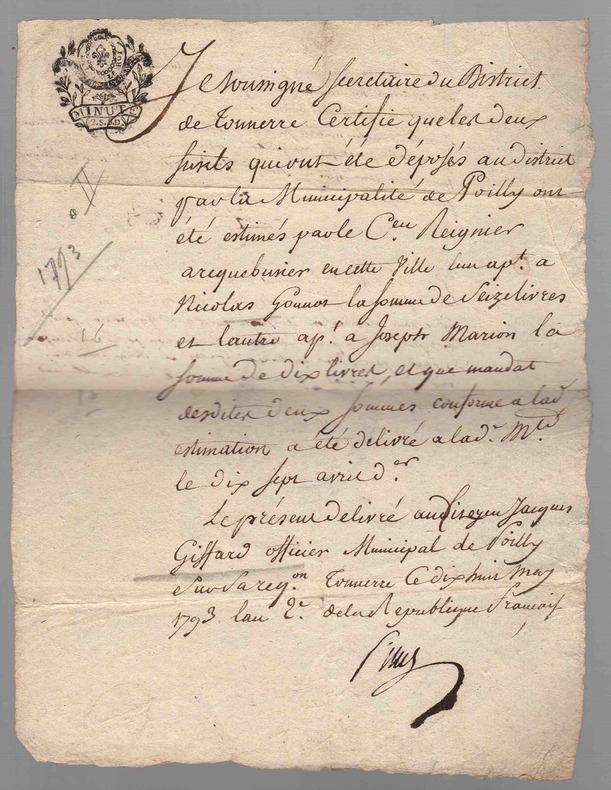
|
|
|
(Álbum manuscrito)
BARCELONA. MONUMENTOS HISTÓRICOS - Barcelona 1953-1954 - Ejemplar único
Barcelona, Escuela Municipal de Formación Doméstica, 1953-54. Álbum manuscrito con fotografías de la ciudad. 28 hojas. Encuadernación en tela. 25 x 20 cm. Muy buen ejemplar.
|
|
|
*
"Tableau de l'arrivée et du départ des bâtiments du Commerce français, tenu par la Frégate L'Herminie dans les différents ports où elle sera mouillée ; à dater du 1er Mai 1831. "
1831. Un feuillet 25 x 30 cm.
Bookseller reference : 5611
|
|
|
*
Analyse des Instructions pour le débarquement des vaisseaux (à l'aide des Chalands, Chaloupes, Bateaux gênois et catalans).
Sans lieu ni date (début XIXème siècle). 3 pp. in folio manuscrits.
Bookseller reference : 5606
|
|
|
*
Division des matières contenues dans la Constitution.
Sans lieu ni date (1791). 4 pp. in 4° manuscrites au XVIIIème siècle.
Bookseller reference : 2833
|
|
|
*
Note sur la somme confiée au Capitaine de l'Escadre et destinée à procurer de la viande fraîche aux équipages.
1827. Un feuillet in folio manuscrit.
Bookseller reference : 5608
|
|
|
*
Notes extraites des Instructions sur les Equipages de ligne.
Sans lieu ni date (dévut du XIXème siècle). Un feuillet manuscrit in folio.
Bookseller reference : 5609
|
|
|
*
Notes sur la Navigation de Rio Janeiro à la Rivière de la Plata.
Sans lieu ni date (début du XIXème siècle). Trois feuillets in folio manuscrits.
Bookseller reference : 5610
|
|
|
*
Reconnaissance des environs de Moustaganem. Avec un plan de Matamora. Sans lieu ni date (début du XIXème siècle). Une feuille 65 x 85 cm pliée.
***
Bookseller reference : 4502
|
|
|
***
Petit carnet imprimé, avec dessins en couleurs, faisant la biographie de quelques généraux et personnalités politiques : M. Franklin Rossevelt, Joseph Staline, Général De Gaulle, Gén. Chiang Kai-Shek, Gén. Eisenhower, Gén. Koenig ...
***. Non daté. In-12. Broché. Bon état, Couv. convenable, Dos satisfaisant, Intérieur frais. Ouvrage de 24 pages, illustré de dessins en couleurs, hors-texte. Police du texte, manuscrite.. . . . Classification Dewey : 91-Manuscrits
Bookseller reference : RO80078984
|
|
|
****
Coutumier Nouveau de la Ville et de tout le Balliage de Grandçon.
Sans lieu, sans nom, [1703]. 22 X 34 cm, [6]-372-[34] pages. Reliure plein veau moucheté d'époque, dos à nerfs, pièce de titre rouge, tranches rouges.
Bookseller reference : 39254

|
|
|
****
Coutumier Nouveau de la Ville et de tout le Balliage de Grandçon.
22 X 34 cm, [6]-372-[34] pages. Coutumier manuscrit Vidimé par le Sieur Emanuel Pretellins Secrétaire lt. du Grand Conseil d'Etat de la Ville et Canton de Berne. Cet exemplaire a été établi sur l'exemplaire signé par Emmanuel Rod, chancelier du canton de Berne, daté de 1703. Avec un "répertoire qui indique les pages en fin de volume". Une édition imprimée de ce coutumier avec divers ajouts et corrections paraitra en 1780 à Yverdon chez J. J. Hellen imprimeur. Exemplaire en parfaite condition.
|
|
|
-
ARTS ET MÉTIERS GRAPHIQUES NO 44.
Directeur : Charles Peignot. Revue bimestrielle publiée à Paris par Arts et Métiers Graphiques le 15 décembre 1934. In-4 (31 cm) 67, (1) pages, nombreuses illustrations in-texte et 7 encartages hors-texte. Broché. Couverture de Annenikov tirée chez Mourlot Frères. Manque de 2 cm à la tête du dos, petit frottis au dos, intérieur en très bel état. [ Complet de tous les hors-texte; quelques images de Grandville, plan de Suresnes, couverture de « Les Contes du Chat Perché » de Marcel Aymé, paysage de Pierre Boucher, planches extraites de la « Nouvelle clef des songes » et des « Oeuvres de Maupassant » et une page d’annonces des « Encres Lefranc ». Ce numéro contient un article (pp. 49-53) sur « Les Manuscrits de Jacques Cartier » de G. Brito. Aussi, des textes de Max Jacob, Mac Orlan, Michel Leiris, Jean Bruller et Claude-Roger Marx ].
Bookseller reference : 3763
|
|
|
--Epreuve unique sur Parchemin-- LABOUREUR (Jean-Emile).
Eau-forte originale sur parchemin, entête de chapitre du livre "Les Caves du Vatican" de André Gide.
1 feuillet de parchemin ancien 254 x 167 mm sur lequel a été tirée une eau-forte (dimensions de la cuvette : 63 x 62 mm). Etat : Léger gondolement et veinage naturel du support, petites taches de rouille en partie gauche, parfait état par ailleurs.
Bookseller reference : 11238
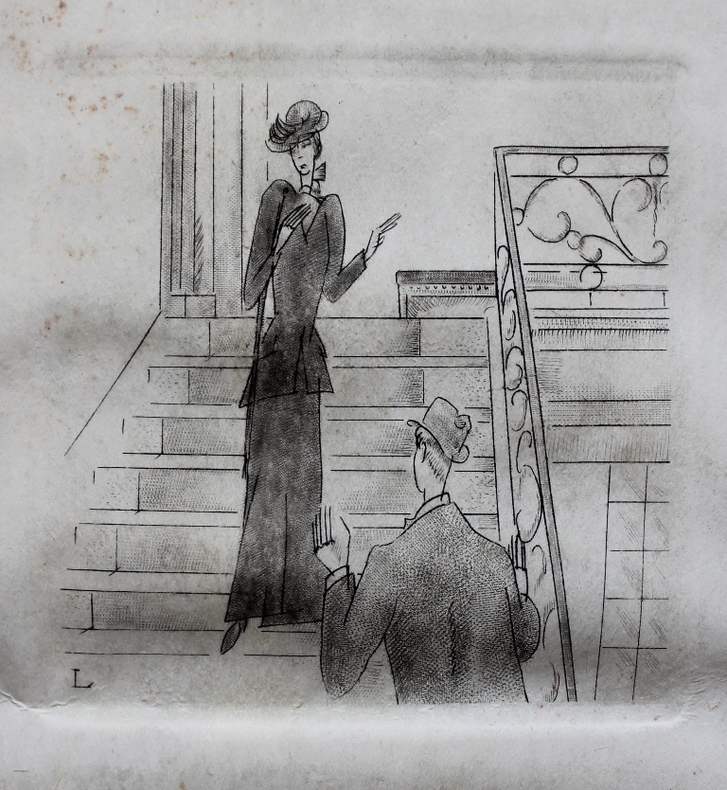
|
|
|
--Epreuve unique sur Parchemin-- LABOUREUR (Jean-Emile).
Eau-forte originale sur parchemin, entête de chapitre du livre "Les Caves du Vatican" de André Gide.
1 feuillet de parchemin ancien 254 x 165 mm sur lequel a été tirée une eau-forte (dimensions de la cuvette : 63 x 60 mm). Etat : Léger gondolement et veinage naturel du support, parfait état par ailleurs.
Bookseller reference : 11237
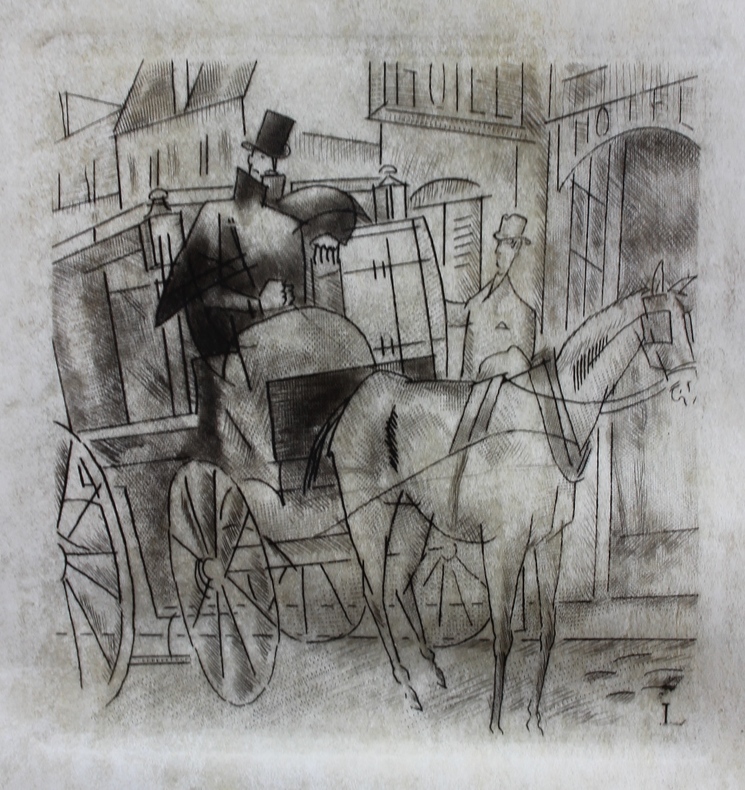
|
|
|
--Epreuve unique sur Parchemin-- LABOUREUR (Jean-Emile).
Eau-forte originale sur parchemin, frontispice du volume II du livre "Les Caves du Vatican" de André Gide.
1 feuillet de parchemin ancien 250 x 166 mm sur lequel a été tirée une eau-forte (dimensions de la cuvette : 148 x 94 mm). Etat : Léger gondolement et veinage naturel du support, pli marginal à gauche, parfait état par ailleurs.
Bookseller reference : 11239

|
|
|
--Exemplaire de tête avec encre originale et poème manuscrit--[TOUCHET (Jacques)] - VOLLAND (Gabriel).
L'Amour vainqueur.
P., L'Edition, 1921, 1 vol. in-8° (226 x 140) relié 1/2 vélin à la bradel, auteur, titre et date dorés au dos, tête dorée, couverture et dos conservés, non paginé.Très bel exemplaire.
Bookseller reference : 11151
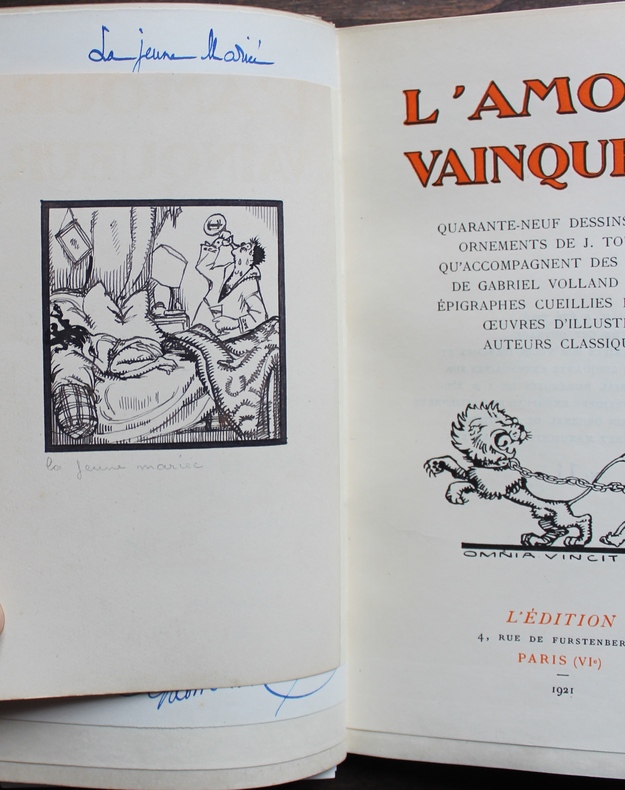
|
|
|
--Important manuscrit original sur la Syphilis-- LANGLEBERT (Edmond).
La Syphilis dans ses rapports avec le Mariage.
Neuilly-sur-Seine, rue Soyez, 28 avril - 12 août 1872, 1 vol. in-4° oblong (195 x 235 mm) reliure de lépoque 1/2 chagrin marron à coins, dos à 4 nerfs, auteur, titre, et fleurons dorés, double filet à froid bordant les plats de papier marbré, de (3) ff. (dédicace, faux-titre, titre) - 446 ff. Petites griffures et frottements sans gravité sur les plats, très bel exemplaire par ailleurs.
Bookseller reference : 14044
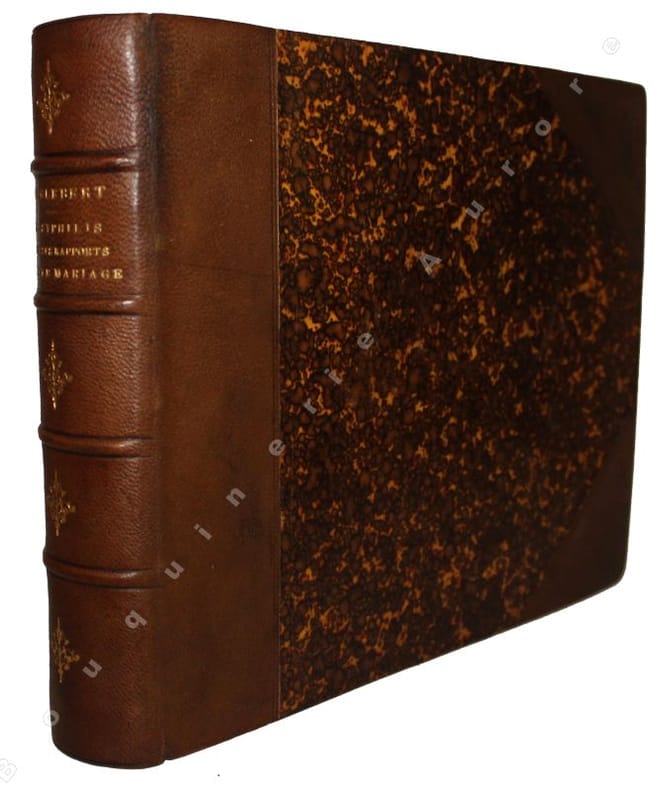
|
|
|
1593 NO. MEDICAL AND HEALTH LAW in APRIL, 24, 1930].
[MANUSCRIPT - EARLY REPUBLICAN MEDICAL and HEALTH LAW] Umûmî Hifzissihha Kanunu.
Very Good Turkish, Ottoman (1500-1928) Original manuscript copy of 1593 numbered Medical and Health Law of Turkish Republic, adopted in April, 24, 1930. No author. 32x22 cm. In Ottoman script. [37] p. Including full 309 articles of law. Written with a fine Riq'a script. "The Ministry of Health was founded on 3 May 1920 with the law no. 3 following the opening of the Grand National Assembly of Turkey. The first minister of health in Turkey is Dr. Adnan Adivar (Husband of famous Turkish female writer Halidde Edip Adivar). In this period, the issues of reconstruction after the war, the healing of the war wounds and formation of the key legislation in oder to found the country's health system were focused on. The foundations of the current public health system in Turkey were laid between the years of 1923 and 1946. In this period, a number of acts were put into effect to clearly and definitely specify the duties and functions of the Ministry of Health which was responsible for planning, arranging and applying the health programs. Such law as the General Health Law (Umumi Hifzissihha Kanunu) (1930/1593) which are still in effect today were enforced...". (Source: Legal, Ethical, Social Aspects of Public Health Care in Europe and Beyond: Croatia, Japan, Portugal and Turkey, Vol. 2).
|
|
|
1815
Billets de logement
2 billets de logement: l'un pour 4 militaires "arrivés à Dijon le 10 septembre 1815"; l'autre pour un officier et son domestique daté du 9 septembre 1815 , avec griffe du maire de Dijon Durande. Très bon Dijon 1815
Bookseller reference : 9408

|
|
|
1815
Bon pour une ration complète de fourrage
pour la subsistance du cheval du soussigné pour la journée du 5 juillet 1815. Cambrai le 5 juillet 1815. Cachet du commissaire des guerres "Jacques". Très bon Cambrai 1815
Bookseller reference : 9407

|
|
|
19th Century Student of Medicine
Journal of Manuscript Medical Notes in German, titled: "Materia Medica und Formulare nach Dr. Büchner" , [Medical Material and Formulas According to Dr. Büchner].
Manuscript notes made by a nineteenth century student of medicine, possibly intent on becoming an apothecary, who examines and records the earlier works of German physician and professor Andreas Elias Buechner (1701-1769), including numerous medicinal recipes and commentary on physiological effects. 8vo. 56 pages in manuscript. Text is in German. Marbled paper boards with blank label to front. Volume measures approximately 17 x 21 cm. Very slight wear to boards, otherwise in very good condition, internally crisp and bright. The 18th century was the 'Golden Age' of scientific academies and learned societies. This work provides valuable information on the historic application of natural ingredients with medicinal qualities, as well as a somewhat early history of the experimentation and progress in the field of medicine, by drawing from the methodology and recipes of a notable eighteenth century German physician and educator in the field - Andreas Elias Büchner. Following a five-point outline, the writer compiles a lengthy and well organized list of medical ailments or discomforts and the simple remedies for them, over 24 pages, a very small sampling of these being parageusia (a distortion of the sense of taste), digestive issues for which are listed various laxatives, skin sensitivities and emollients, "alterantia" or hormonal alterants, and diaphoretics. A section headed "Special Formulas," comprising 23 pages of more complex medicinal recipes, provides ingredients and measurements for various emulsions, syrups, pills and much more. Andreas Elias Büchner (1701-1769) was a German physician, naturalist, Professor of Medicine at some of Germany's leading institutions, president of the German National Academy of Sciences Leopoldina from 1735 to 1769, and one of Friedrich Hoffmann's most zealous followers. Manuscript
|
|
|
3 HÜREL - FERIDUN HÜREL, (One of member and founders of Turkish Rock Band 3 Hürel), (1951-).
Original photographic advertisement of 'Üç Hürel' signed and inscribed 'Feridun'.
Very Good Turkish Original b/w advertisement of Turkish Rock Band Üç Hürel, signed and inscribed by Feridun Hürel as 'Atilla'ya sevgiler'. Oblong: 11x16,5 cm. In Turkish. Photograph on the advertisement shows three members and brothers of Üç Hürel. Üç Hürel was a Turkish rock band, formed in 1970 by brothers Onur, Haldun and Feridun Hürel. Considered as among Turkey's most popular Anatolian rock bands, the band performed folk-driven pop and rock music and occasionally also paraphrased classic folk songs with considerable ingenuity. Their lyrics generally featured themes such as peace and freedom. Hürel brothers were born in Trabzon and later moved to Istanbul due to family business. In 1966, the brothers formed their first band, Yankilar, which was later renamed to Istanbul Dörtlüsü. The band performed in small music halls and tried to synthesize Turkish music and traditional rock formats. After forming a number of other bands, including Trio Istanbul, Oguzlar, and Biraderler, Feridun became a member of the Selcuk Alagöz Orchestra. Haldun and Onur later joined him to gain experience and earn money for new equipment. In 1970, they left the orchestra to form 3 Hur-El. Following the release of their debut single in 1970, "Ve Ölum/Seytan Bunun Neresinde," the band released two LPs and more than ten singles in six years. In 1977, Haldun and Feridun left the band for mandatory military service. Coping with the loss of their mother to a traffic accident, the brothers quit music. Feridun moved to England but returned without any significant accomplishments, subsequently returning and specializing in advertising. Onur took a job as an instructor and Haldun started a ceramics and textiles business. 3 Hür-El reunited in 1996, releasing two records in 1996 and 1999, respectively. The band's 1970 song, "Ve Ölüm", was featured in the 2013 Serge Bozon film, Tip Top. (Source: Wikipedia).
|
|
|
3. KAFKAS FIRKASI KUMANDAN VEKILI AVNI.
Autograph correspondence signed 'Üçüncü Kafkas Firkasi Kumandan Vekili Avni'.
Very Good Turkish, Ottoman (1500-1928) Original manuscript autograph letter / correspondence signed 'Üçüncü Kafkas Firkasi Kumandan Vekili Avni'. 18x11,5 cm. In Ottoman script. 1 p. Full. It starts with 'Huve'. Dated 8/6/[13]35 AH = [1919 AD]. Written from Trabzon to Mühimme? Mintikasi levâzim reisi Yüzbasi Rafet Efendi. "1) 27 Tabur Kumandan Vekâleti'nde bulunan Yüzbasi Mehmed efendi ile mezunen terhisi kolordudan emir verilmistir. Mezkûr tabur kumandanligina vekâleten mühimme? mintika levâzim reisi Rafet Efendi tabi'kilinmistir. 2) 12. Alay Kumandanligina ve Yüzbasi Rafet Efendi'ye teblig kilinmistir. / Reply to Yaver Mustafa Efendi. An Ottoman army auttograph of Kafkas Army.
|
|
|
[ Condé, Prince de - Baronne de FEUCHÈRE } GATIGNY, intendant du duc de Bourbon.
Lettre de chantage adressée à Louis Henri Joseph, Duc de Bourbon puis Prince de Condé (1756-1830)L.A.S. adressé au duc de Bourbon " en son château de Chantilly".
Paris, 23 janvier 1830.
Bookseller reference : 3016
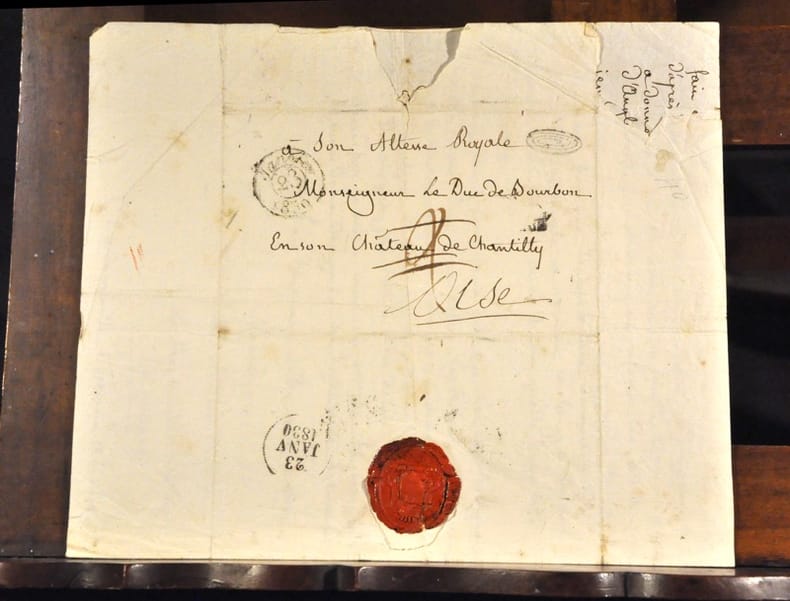
|
|
|
[ d'après VALOUS Vital de.]
Les Origines des Familles consulaires de la Ville de Lyon depuis l'établissement de la Commune jusqu'en 1790. Notes rédigées sur les Documents originaux par Vital de Valous, Lyon, à la Librairie d'Auguste Brun, rue du Plat, 1863,
Vers 1863, 1 volume in-4 de 200x290 mm environ, demi-chagrin bleu marine, dos à 5 nerfs portant titres dorés, gardes marbrées. Copie manuscrite d'après le manuscrit original de M. de Valous (87 p.) suivie de la copie manuscrite des notes de M. de Valous sur son ouvrage (19 p.). Bon état.
Bookseller reference : 115024

|
|
|
[ GERUZEZ ANDLAUER, Jeanne ; PRUDHOMME, Sully ]
Manuscrit [ Recueil de poésies et pièces diverses, dont copies de poèmes de Sully Prudhomme au verso de 5 faire-parts de mariage de Jeanne Geruzez, fille de Victor Geruzez, ami de Sully Prudhomme plus connu sous sous pseudonyme d'illustrateur : Crafty ]
1 cahier manuscrit recouvert de velours et tissu brodé, environ 90 feuillets et 5 faire-parts joints, s.d. [ circa 1890-1900 ]. Rappel du titre complet : Manuscrit [ Recueil de poésies et pièces diverses, dont copies de poèmes de Sully Prudhomme au verso de 5 faire-parts de mariage de Jeanne Geruzez, fille de Victor Geruzez, ami de Sully Prudhomme plus connu sous sous pseudonyme d'illustrateur : Crafty ]
Bookseller reference : 59299

|
|
|
[ GERUZEZ ANDLAUER, Jeanne ; PRUDHOMME, Sully ]
Manuscrit [ Recueil de poésies et pièces diverses, dont copies de poèmes de Sully Prudhomme au verso de 5 faire-parts de mariage de Jeanne Geruzez, fille de Victor Geruzez, ami de Sully Prudhomme plus connu sous sous pseudonyme d'illustrateur : Crafty ]
1 cahier manuscrit recouvert de velours et tissu brodé, environ 90 feuillets et 5 faire-parts joints, s.d. [ circa 1890-1900 ]. Rappel du titre complet : Manuscrit [ Recueil de poésies et pièces diverses, dont copies de poèmes de Sully Prudhomme au verso de 5 faire-parts de mariage de Jeanne Geruzez, fille de Victor Geruzez, ami de Sully Prudhomme plus connu sous sous pseudonyme d'illustrateur : Crafty ] Le document est rendu très intéressant par la présence de 5 faire-parts du mariage de Jeanne Geruzez, fille de Victor Geruzez dit "Crafty" et Joseph Andlauer, chacun de ces faire-parts joints portant au verso la copie de poèmes de Sully Prudhomme, dont certains connus et publiés (ainsi "Hazards" ou "Songe d'Enfants" dédié à Mme G. [ Gabrielle ] Geruzez) mais il propose notamment un poème non intitulé et probablement inédit, dédié "A Jeanne Geruzez pour ses fiançailles", daté du 2 avril 1898 : "Jeanne, vois le printemps doucement radieux / Pas à pas revenir, réparateur fidèle / Il redresse le lys penché sur l'asphodèle / Il même la rosée à celle de tes yeux [ ... ]". Le cahier manuscrit recueille de nombreuses copies de poèmes (de Victor Hugo, Théodore de Banville, Musset, Casimir Delavigne, José Marie de Heredia, etc...), de textes historiques ou parfois scientifiques. Anonyme, le document peut-être très probablement attribué à un membre de la famille Géruzez. Eugène Geruzez, père de Crafty, était docteur es lettres et critique littéraire. Bon état Français

|
|
|
[ HUYSMANS Joris Karl ]
Extrait des minutes des Actes de Naissance reconstitués en vertu de la loi du 12 février 1872 - De l'ancien 11e arrondissement de Paris - Année 1848 -
1471 1 page et demi in-4 - Extrait daté du 7 février 1898 -
Bookseller reference : GF23623
|
|
|
[ACQUET D'HAUTEPORTE]
2 pièces manuscrites in-4.
Décharges pour Jacques-René Acquet d'Hauteporte pour rentrer au Collège de la Flèche [produit contrat de mariage de Pierre Acquet, 1er janv. 1663 et transaction en date du 17 juil. 1679]. Signé Richemont, capitaine de dragons au régiment de Damas et chev. de St Louis. P., 8 mars 1771 et 2 avril 1773.
Bookseller reference : 596847
|
|
|
[Adametz, Teresa, Chilean educator (1846-1917)].
Lira Chilena. El 3er Curso de la Escuela Normal de Preceptoras. Dedica este pequeño trabajo a su noble i abnegada Directtora Sta. Teresa Adametz. Santiago de Chile, 15. X. 1888.
4to. Spanish manuscript on paper. 189 written pages on 97 ff. within black ink rules. Contemporary full leather binding over bevelled wooden boards, title and lyre design giltstamped to upper cover, Chilean arms to lower cover, floral ornamentation and title "Poesias" to spine. Gilt dentelle along bevelled outer as well as inner edges. All edges goffered and gilt. Dedication manuscript for Miss Teresa (Therese) Adametz, director of Santiago's pioneering teacher training college "Escuela Normal de Preceptoras" between 1885 and 1890. In 1910, the writer, educator and later Nobel laureate Gabriela Mistrál would receive her long-sought degree from this institution. - The volume constitutes an anthology of Chilean poetry, each section introduced by a brief outline of the life of the respective writer, including such poets as Eusebio Lillo, Isidoro Errázuriz, or Luis Rodriguez Velasco. Penned in fine and regular cursive calligraphy, with blackletter headlines decorated with ornamental penwork flourishes, this sumptuously bound volume was produced by the college's third class as a gift for the Silesian-born educator Adametz, formerly in charge of an Austrian girls' boarding school for the daughters of military officers (cf. Actividades femeninas en Chile [Santiago 1928], pp. 145f.). The dedicatory poem is signed "Rita Gomez Oviedo", while the final entry ("[L]a escuela qué goces") is signed "Pilar Montecinos C.". - An old stamped shelfmark "5.164" to the lower edge of the title-page. Beautifully preserved.
|
|
|
[Adelsrecht].
Militär-Adel. [Österreich, ca. 1845].
Deutsche Handschrift auf Papier. 23 SS. auf 14 Bll., halbbrüchig beschrieben. In originalem Papierumschlag mit kalligr. Titel. Lose Bögen. Kl.-Folio (225 x 286 mm). Interessante Kompilation von Erlassen und Dekreten, im wesentlichen betreffend den 1757 in den österreichischen Erblanden eingeführten "systemmäßigen Adel", ein Standesvorrecht, das bürgerlichen Offizieren unter bestimmten Bedingungen einen Rechtsanspruch auf Erhebung in den erblichen einfachen Adelsstand garantierte. - Das Dokument eröffnet mit einem "Vortrag des Directorii in Publicis et Cameralibus an Kais. Mar. Ther. v. 23. Okt. 1752": eine Vorlage zu der von Maria Theresia geforderten Beseitigung aller Unterschiede bei Nobilitationen und Standeserhöhungen zwischen den böhmischen und österreichischen Hofkanzleien, gegenseitiger Anerkennung ohne "der ehmals üblich gewesten neuerlichen Ansuch und Erlangung des selben respectu Standes" und Vereinheitlichung der dazu gebräuchlichen Siegel. Damit war eine wichtige Voraussetzung für die Einführung des systemmäßigen Adels geschaffen. Präsident des 1749 geschaffenen "Directorium in publicis et cameralibus", der Verwaltungsbehörde, die den erwähnten Hofkanzleien vorstand, war Friedrich Wilhelm von Haugwitz. Am 12. Jänner 1757 wurde der systemmäßige Adel per Allerhöchster Entschließung der Kaiserin eingeführt: "Laut Publikazion vom Jän 1757 hat M. Theresia aus allermildester Neigung für das Militär zu entschließen geruht, daß jede, Offiziere so auch von der Fortuna sein Aufkommen hat, nachdem er 30 Jahre gedient und seines Wohlverhaltens wegen von seinem vorgesetzten Kommandanten ein gutes Zeugnis beizubringen beizubringen vermag, auf Ansuchen das Ritterschaftsdiplom gratis ertheilt werden solle". - Bereits im April des Jahres erfolgten auf Anweisung des Hofkriegsrats erste Einschränkungen des Privilegs: "Im April 1757 wurde dieß dahin modifiziert, daß der erbländische Adel mit Nachsicht der Haupttaxe ertheilt werde, die Nebengebühren aber bezahlt werden sollen." Bis 1845 sind weitere Verschärfungen dokumentiert, aber auch Entscheidungen zur Form von Stammbäumen oder etwa die Festellung, dass "den Chefs der 2 Linien der fürstl. Familien Schönburg [...] und der 5 Linien der fürstl. Familien Salm" die Titulatur "Durchlaucht" gebührt (Hofkanzleidekret vom 4. Februar 1845). - Der Umschlag mit Einrissen, zwei Ausschnitten am Hinterdeckel und fleckig. Die Textseiten leicht gebräunt und minimal fleckig.
|
|
|
[ADHEMAR de LANTAGNAC] (Provence)
Ensemble de 3 pièces manuscrites in-8 et in-4.
Décharge pour Mlle de Lantagnac pour rentrer à St Cyr. Signé Chabrol, Monaco, 29 août 1764, 3 pp. Autre décharge, signé Adhémar de Lantagnac, P., 14 février 1781 [contient la généalogie de Rose-Anne-Françoise d'Adhémar de Lantagnac, née le 13 janvier 1771, par d'Hozier]. Inventaire de titres, signé Albini, P., 12 juillet 1790, 2 pp. Notes de d'Hozier.
Bookseller reference : 596844
|
|
|
[ADONVILLE] (Beauce)
2 pièces manuscrites in-8.
Lettre adressée à M. d'Hozier pour reprendre les titres confiés, signé Vigny, Paris, 11 mai 1772. Notes et signature de d'Hozier. - Décharge pour Auguste d'Adonville pour être reçu page à la Vénerie, Etampes, 8 avril 1781, signé d'Adonville et Bugros d'Arcy.
Bookseller reference : 596848
|
|
|
[AGUISY] (Champagne)
2 pièces in-8 et in-4.
Décharge (imprimée) pour Gabrielle Jeanne Eléonore d'Aguisy, reçue dans la Maison Royale de St Louis et St Cyr, signé Montgarde, Paris, 21 aoust 1762. - Remise du contrat de mariage du 27 nov. 1777 et extrait baptistaire du 9 mai 1752, signé d'Aguisy, Paris, 1er mars 1784.
Bookseller reference : 596849
|
|
|
[Aguétant (Pierre)] Vacaresco (Hélène. Bucarest, 1864-1947).
Important dossier manuscrit :
1- Tapuscrit signé, corrigé à la main de la Préface du Poème du Coeur (1914) ; in-4, 6 ff. 2- Manuscrit de la Préface du Poème du Beaujolais ; in-4, 7 ff. 3- "Pierre Aguétant jugé par l'amie de Carmen Sylva" : tapuscrit signé, corrections autographes ; in-folio, 5 ff. 4- Tapuscrit signé "À ajouter à la Préface. Paris 25 février 1923" ; in-4, 2 pp. ; passages autographes signés. 5- Correspondance (15 pièces) avec Pierre Aguétant : L.A.S. et cartes postales de 1913 à fin 1925.
Bookseller reference : 12832
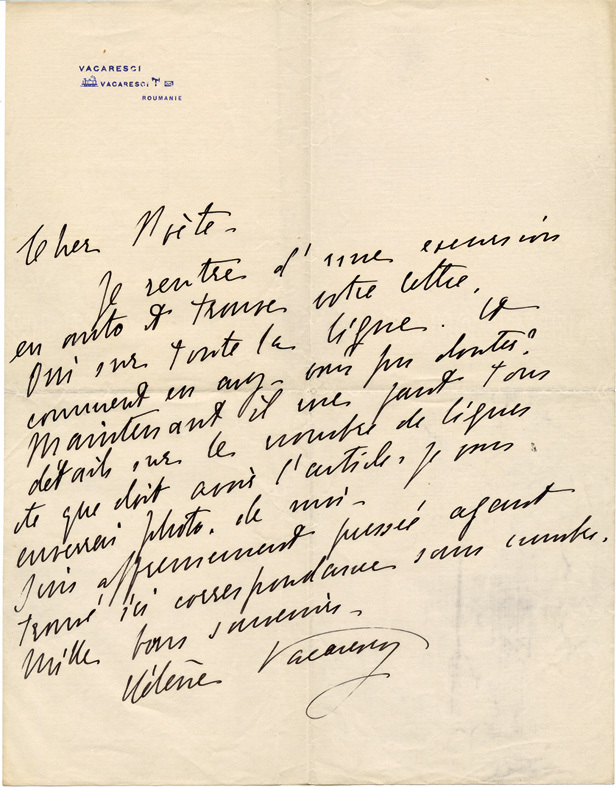
|
|
|
[Aichen, Johann Joachim von].
Prières quotidiaines pour la sainte confession, communion et la messe [...]. O. O., um/nach 1718.
(164) SS. Französische und deutsche Handschrift auf Papier. Mit einigen unbeschriebenen Seiten. Titel und ein Vorsatzblatt auf Pergament. Rot eingefärbter blindgepr. Lederband der Zeit. Marmorvorsätze, dreiseitiger Goldschnitt. 8vo. Hübsches Gebetbuch des niederösterreichischen Land-Untermarschalls und Präses des nö. Ritterstandes Johann Joachim von Aichen (1664-1729). Zwei Drittel der Handschrift in französischer Sprache; durchgehend in ansprechender Kalligraphie. Mit eh. Besitzvermerk am Titelblatt unter Verwendung des Titels des Land-Untermarschalls, der Aichen im Jänner 1718 verliehen wurde, woraus sich das frühestmögliche Entstehungsdatum der Handschrift ergibt: "Mier Johann Joachim von Aichen L. U. Marschall gehörig". Ein kurzer Bericht über die Bruderschaft des heiligen Donatus in Arles mit einem Gebet zur Verschonung vor Unwettern in flüchtiger Kurrentschrift, datiert 1742, belegt eine Weiterführung des Büchleins nach von Aichens Tod. - Kleines Exlibris am Vorsatzblatt, datiert 1874 ("Homo hominibus"). Vorderdeckel leicht aufworfen. Papier durchgehend etwas gebräunt; die Ränder fingerfleckig.
|
|
|
[Aichen, Peter von].
Doktordiplom der juridischen Fakultät der Universität Siena für Peter von Aichen, später Regierungsrat und niederösterreichischer Landschreiber. Siena, 12. X. 1645.
(8) SS. in Schwarz und Goldschrift. Pergamentlibell. Lose einliegend in originalem Prachteinband, Leder mit reicher Deckelvergoldung. 4to. Schöne Doktorurkunde, ausgestellt von Annibal Melarius, Generalvikar des Erzbischofs Asciano II. Piccolomini. Mit eh. Unterschrift des Vincentius Barcius für Franciscus Barcius. Nach Erlangung des Doktortitels wurde Peter von Aichen 1647 Sekretär beim nö. Landmarschallsgericht, 1656 Regierungsrat und 1661 nö. Landschreiber. Am 18. Februar 1666 wurde Peter von Aichen unter die neuen Geschlechter des nö. Ritterstands aufgenommen; er kaufte das Gut Inzersdorf bei Wien. Am 16. März 1674 folgte seine Aufnahme unter die alten nö. Ritterstandsgeschlechter. - Mit wohl eh. Besitzvermerk am Vorsatzblatt: "Peter v. Eichen Dr. Diplom 1645". Rücken oben aufgeplatzt, Bug unten eingerissen; vereinzelte Spuren von Wurmfraß. Schließbänder fehlen.
|
|
|
[AIGUIRANDE] (Berry)
Une pièce manuscrite in-4.
Décharge pour actes de contrat de mariage du 24 juil. 1771, célébration du mariage le 14 août suivant, extrait baptistaire de 1735 et certificat d'ancienne noblesse délivré le 16 janv. 1760, par M. Beaujon. Signé d'Aiguirande, major de dragons, chev. de St Louis, Paris, 7 janv. 1788.
Bookseller reference : 596850
|
|
|
[ALAIN-FOURNIER] - BEREILH-LIEGAUX (Jacques).
Alain-Fournier.
Tapuscrit original inédit, en feuilles, (21 x 30 cm) sous chemise à rabats. 6 parties présentées chacune sous chemise de papier bleu avec le titre manuscrit : 1f.-3pp. - 30pp. - 2ff.-20pp. - 1f.-91pp. - 1f.100pp. - 1f.-15pp. Tâche angulaire sur les 4 premiers feuillets. Quelques corrections manuscrites. Bel état.
Bookseller reference : 11760
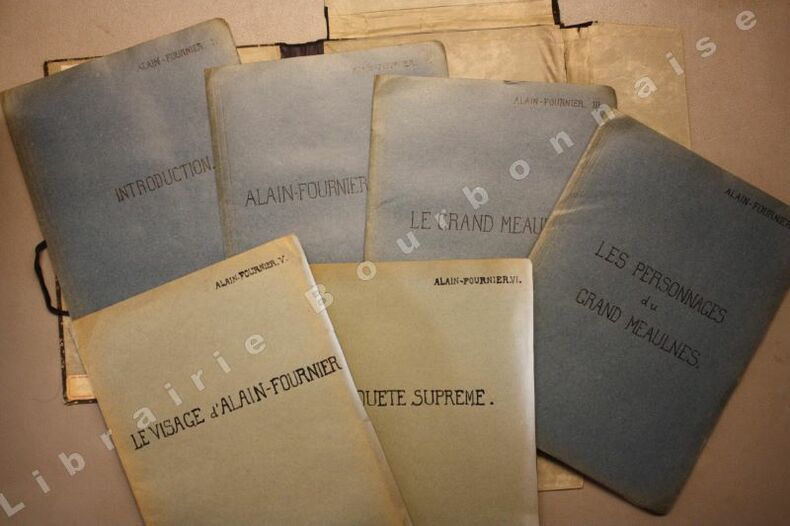
|
|
|
[Alchemical manuscript].
Alchemical manuscript on vellum containing a series of complex symbols, diagrams and cipher text. [Northern Italy, not before 1560s].
4to (159 x 218 mm). Latin and Italian manuscript on vellum. 16 leaves, the first part containing notarial records of land ownership paginated 1-15; the second half with 14 pages of symbols, diagrams and cipher text, in red ink. Stored in custom-made morocco-backed clamshell case. An unusual and sophisticated alchemical manuscript showing a range of influences from Paracelsus to the Kabbalah. - Beginning in the middle of the single gathering, the manuscript contains a series of complex symbols and diagrams with cipher text, encoding alchemical processes. The illustrations start off with a symbol incorporating four watchtowers, a Star of David, and alchemical glyphs; later images include various furnaces, stills, and other apparatus, a seven stage ascent beginning with a flask and culminating in a throne (probably representing chemical processes), a fountain (similar to the opening image of the Rosarium Philosophorum), an alchemical rebis, a tree growing on a tomb with seven mountains in the background, a fruit bearing tree growing from a male figure impaled on a sword, a bird (apparently an owl) with an alembic on its head, and a distillatory furnace, many of the images partly composed of lines of cipher characters and incorporating various glyphs, also with diagrams of geometrical speculation, tables with Hebrew letters (perhaps showing permutations of solar and lunar qualities), and related material (ff. 9-15v). - Paracelsian influence is in evidence in the manuscript's list of the three essential ingredients of the Philosophers' Stone (Mercury, Sulphur, Salt), while the geometric representations of these tria prima resemble those found in the works of the Belgian alchemist Gerard Dorn (1530-84). Jewish elements include the use of Hebrew characters and the appearance of a Menorah in the rebis figure. The accompanying text is entirely in a cipher which resembles that of the Aiq Bekr or Kabbalah of the Nine Chambers. This manuscript reveals an alchemist whose work combines in a unique way many features found in contemporary practitioners such as, in England, John Dee. - Prefixed to the alchemical section is a series of notarial records including land transactions and a will, dating from 1537 to 1561 (providing the terminus post quem for the succeeding part) and localisable to northern Italy, specifically the Veneto (there is mention of a church of "Sancti Floriani de Rippa", or Riva, and of Venice itself). - Some staining, smudging to a few images and tears to outermost leaves. - Provenance: Sotheby's, 26 November 2008, lot 7.
|
|
|
[Alchemical manuscript].
An alchemist's handbook, in German. Illustrated manuscript on paper. [Germany, ca. 1480/90].
Small 4to (140 x 195 mm). 91 leaves, 149 written pages in two hands, the main body of the text complete, up to 29 lines per page, ruled space 85 x 155 mm. Incipit: "In nomine domini amen. Noch dem also gesprochen ist daß alle kunst kunftigk ist von got und ist by im on ende...". Rubrics touched in red, calligraphic initials in red and some with flourishing, 25 watercolour illustrations of scientific apparatus, 10 mathematical and architectural diagrams in pen. 15th century German calf over wooden boards, tooled in blind with vertical rows of hunting scenes within a triple-filet frame, remains of two fore-edge clasps. Stored in custom-made half morocco clamshell case. A Renaissance alchemist's handbook, quoting Al-Razi by name and deeply rooted in the Islamic tradition of alchemical art. An intriguing manuscript which bears witness to early practical chemistry in 15th century Germany and to the immense influence of Arabic alchemy, illustrated with talented watercolour diagrams of the associated apparatus. - Indeed, the word 'alchemy' itself is derived from the Arabic word 'al-kimia', and it was Al-Razi who claimed that "the study of philosophy could not be considered complete, and a learned man could not be called a philosopher, until he has succeeded in producing the alchemical transmutation". Alchemy and chemistry often overlapped in the early Islamic world, but "for many years Western scholars ignored Al-Razi's praise for alchemy, seeing alchemy instead as a pseudoscience, false in its purposes and fundamentally wrong in its methods, closer to magic and superstition than to the 'enlightened' sciences. Only in recent years have pioneering studies conducted by historians of science, philologists, and historians of the book demonstrated the importance of alchemical practices and discoveries in creating the foundations of modern chemistry" (Ferrario). The quest to transmute base metals into gold and to obtain the Philosophers' Stone was a practical as well as theoretical pursuit, as attested by the existence of this manuscript. The main body of the text opens on fol. 5 with an introduction to the art of alchemy, whose practice requires reference to the ancient authorities. Recipes for the various pigments, solutions, acids and alkalis are listed in groups, before descriptions are given of the planets relevant to the alchemist's art, starting with Saturn, and their effect on the elements, again with reference to the ancient authorities including Al-Razi, Origen, Aristotle, Albertus Magnus, and Hermes Trismegistus. There follow notes on the ease of obtaining various elements, before lists of alchemical compounds - including 'sal petri' and 'aqua lunaris' - are grouped according to their nature. Practical instructions, organised by chapter, begin on fol. 17v with the manufacture of vermillion and 'spangrün'; the first of the illustrations depicts two vessels for the burning of cinnabar. Further recipes involve the burning of various substances - illustrated with drawings of furnaces, cucurbits and other vessels, and distillation apparatus - before moving on to the manufacture of acids, bases and oils, mentioning the use of quicksilver, then, finally, turning to the manufacture of gold. The end of the text on fol. 69 is marked with the words 'Alchimia & Scientia' in red ink with calligraphic flourishes, above a floral device. - Collation: written by another scribe and bound before the alchemist's handbook (ff. 5-69) are astrological calculations, including those charting the trajectories of the Sun and the Moon (ff. 1-4, obviously incomplete). At the end, 9 leaves with geometrical calculations, illustrated with pen diagrams (ff. 70v-78, apparently incomplete, 2 leaves loose). The last 12 leaves are blanks (ff. 79-91). - Condition: The binding is sound and intact, but shows significant losses to the upper cover; spine entirely lost. Two leaves loose at the end of the manuscript, outer margins waterstained and tattered, surface soiling most notable to f. 1. Occasionally loose and split at gatherings; presence of bookworm damage on some pages; very occasional wax stains. - Provenance: 1) The script, watermark and binding indicate that the manuscript was made in Germany in the final two decades of the 15th century. The watermark visible on certain pages - a heart beneath a crown, above 'Ib' - is closest to a motif widely used in Germany around 1480-1500 (cf. Piccard 32464-32481), and the binding is contemporary. The pastedowns, taken from a Litany of Saints, are also roughly contemporary. 2) This compendium of cryptic knowledge seems to have lain undisturbed for many years after its compilation: the contemporary stamped leather binding is preserved and no booklabels or ownership inscriptions mark the manuscript changing hands. 3) Zisska & Schauer, 4 May 2010, lot 6. 4) Braunschweig Collection, Paris. - The first pigment recipe books in German would not be published until the 1530s (cf. Schießl, Die deutschsprachige Literatur zu Werkstoffen und Techniken der Malerei, 1989). While the manual at hand never appeared in print, a much later manuscript of the same text, apparently copied by no less an authority than the botanist Hieronymus Bock (1498-1554), survives in Heidelberg's University Library under the title of "Ordenlicher proces der waren alten heimlichen kunst der alchymey in drey bucher gestelt" ("Alchemistisches Kunstbuch", Cod. Pal. germ. 294, dated to the middle or third quarter of the 16th century). Unlike the vividly coloured and deftly shaded illustrations in the present volume from the 15th century, the unsophisticated pen drawings in the later Palatina manuscript were clearly executed by the scribe himself rather than by a trained artist. Also, our manual contains additional illustrations at the end, showing some of the most necessary equipment on a double-page spread, as well as five additional pages of recipes for "lutum sapientiae", "postulatz golt" etc., some parts written in a secret cipher, all of which are lacking from Bock's copy. - A unique survival: the Schoenberg Database of Manuscripts lists no more than eight 15th century German alchemy tracts in institutional possession worldwide. Schoenberg Database SDBM_177979. G. Ferrario, Al-Kimiya: Notes on Arabic Alchemy. In: Chemical Heritage, 25 (2007), 32ff.
|
|
|
[Alchemy].
"Opuscula Alchymica". Alchemical manuscript. Germany, 18th century.
Folio (200 x 318 mm). German manuscript, ink on paper. 81 ff., written on rectos and versos. Modern mottled quarter calf over marbled boards, spine stamped in blind and titled in gilt. A German alchemical manuscript comprising five treatises in five different hands. The first part is an anonymous essay on the medical aspects of human excrement ("Auß den Microcosmischen excrementis oder Stercore humano können Medicamenta gemacht werden [...]"); the second, also anonymous, is a brief treatise on the Philosopher's Stone ("Meine meinung den Lapidem Philosophorum zu erlangen ist diese [...]"). Part three is a commentary on the 1660 Amsterdam edition of Joachim Poleman's "Novum Lumen Medicum". Poleman was an adherent to the ideas of Johann Baptista van Helmont (1579-1644) and Ramon Lull. The "Novum Lumen Medicum" is Poleman's elucidation of Helmont's teachings on the secret of philosophers' sulphur, which involved bloodstone, spirit of wine, and "alzali" (alkali?) to produce a sulphuric tincture. First published in 165m the book enjoyed considerable success in many later editions and translations. - The fourth section is a commentary on Johann Gottfried Jugel's "Prima Materia Metallorum", first published 1754. It is one of several works on metals and chemistry by Jugel, and discusses the properties of various substances. The final section presents material from a work attributed to Herward von Forchenbrunn and to Jospeh Kirchweger (d. 1746) titled "Aurea Catena Homeri", which concerns sulphurs and metals and their various medicinal applications. The attempt to distinguish and separate true applicable science and medicine from the traditional occult arts is strongly indicated in the contents of this manuscript. - Browned throughout due to paper stock; some foxing, but well legible throughout. A late 19th century label mounted on the first leaf lists some of the contents. Attractively bound. - Provenance: Emanuel Mai, Catalog des Bücher-Lagers (Berlin 1854), no. 264; later sold by James and Mary Laurie, Booksellers, of St Paul, Minnesota. Last in the library of the noted Russian-American photographer and biologist Roman Vishniac (1897-1990). Cf. Thorndike VII, 231.
|
|
|
[Algérie] - [Assemblée nationale constituante] - Georges Gaumont
Proposition de loi portant définition des biens vacants et leur qualification comme tels, notamment en agriculture, déposée par M. Gaumont, Georges (P.L. 63-02)
1963 La proposition de loi telle que déposée à l'Assemblée constituante algérienne en 1963 (4 pp. - 3 exemplaires), une autre version (3 pp. - 25 exemplaires thermocollés), deux versions préparatoires (copies carbonne du tapuscrit) dont l'une sur papier rose et l'autre comportant quelques corrections autographes.
Bookseller reference : 2012
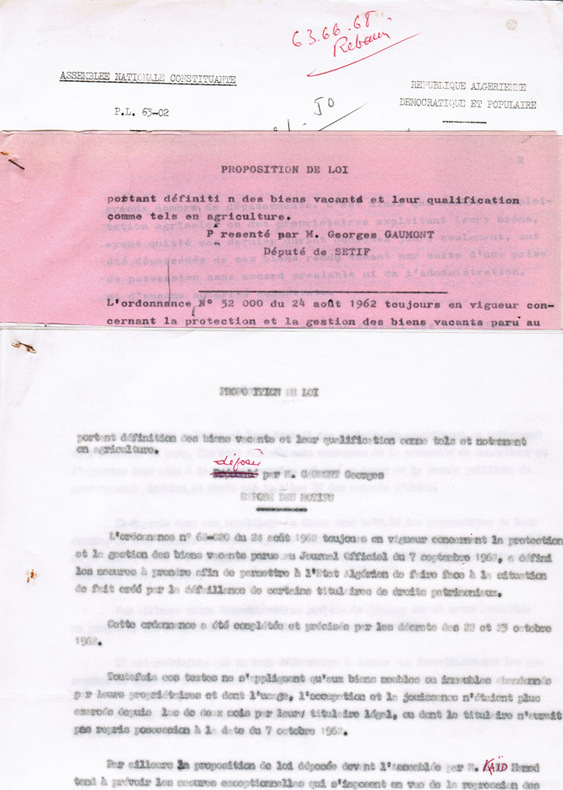
|
|
|
[ALLIER]. MANUSCRIT XIXe.-
Gannat 3me arrondissement. Extraits des mémoires sur les châteaux et abbayes du dépt de l'Allier, envoyés par Messieurs les Sous-préfets et Maires des Communes à Monsieur le Préfet de l'Allier.-
1. Mémoires de M. de Sartiges sous-préfet de Gannat du 30 aoust 1810. 2. Copie de la lettre de M. Amelot sous-préfet de l'arrondissement de Montluçon en réponse à celle par laquelle le préfet lui demandait des renseignements sur les anciens châteaux et abbayes, etc. du 16 juillet 1810. 12 pages in-4 (ca 170 x 225mm) d'une écriture fine particulièrement lisible. C'est la description des différents châteaux de l'arrondissement de Gannat à l'exception de celui de Chantelle pour lequel le rédacteur renvoie à Nicolas Nicolay, 20 châteaux anciens soigneusement décrits et court paragraphe sur les châteaux modernes. Pour l'arrondissement de Montluçon 3 châteaux et 3 abbayes succinctement décrits. Quelques dessins maladroits, au crayon sur les pages non écrites. Intéressant document.
Bookseller reference : ORD-15460
|
|
|
[AMELIN DE BEAUREPAIRE] (Périgord)
Une pièce manuscrite in-8.
Monsieur d'Hozier est chargé de remettre un titre (testament de 1574) produit pour Anastasie [Dammelin] de Beaurepaire pour rentrer à la Maison royale de l'Enfant-Jésus. Signé Beaurepaire et Thianges, Paris, 22 nov. 1776.
Bookseller reference : 596851
|
|
|
[Anatomy of the Ottoman Empire].
L'Anatomie de l'Empire des Ottomans. Declarant l'Origine, Conquestes, Loix, Religion, rentes et fortes des Turcs [...]. No place, 1661.
4to (167 x 235 mm). French manuscript on paper. (1 blank, 4), 75 ff. Cursive script in light brown ink, per extensum, left and right margins ruled in lead pencil. Contemporary unsophisticated cardboard with handwritten calligraphic title, date and a skilfully executed drawing of a grashooper to upper cover. Unpublished, highly interesting 17th century French manuscript about the history, religion, and topography of the Ottoman Empire, written to convey in brief the essentials of the Muslim world. Chapters include "Origine des Turcs et leurs conquestes", "De la Secte de Mahomet et des Loix et Polices des Turcs" (an extensive discussion of Islam and the Prophet), "Estat present de l'Empire des Ottomans" (on the Ottoman state), "Princes confinans avec l'Ottoman", "Princes pretendans sur cest Empire", "La maniere de faire une ligue contre les Ottomans", and "Moyen d'attaquer, abbatre et aneantir l'Empire des Turcs". At the end, the manuscript also mentions Arabia "on the Red Sea" and the port of Jeddah, "where the pilgrims of Mahomet disembark for Mecca". Further, the author discusses navigation of the Red Sea (dangerous at night) and the coast of the Arabian Peninsula, including the port of Aden, Ras Fartak, Norbat (Ash Shuwaymiyyah) opposite the Khuriya Muriya Islands, Muscat, the Kingdom of Ormuz and other places in the Gulf under Portuguese rule. - Occasional slight brownstaining, lower half of title-page defective and rebacked (apparently without loss), otherwise a well-preserved, well-legible manuscript, untrimmed in its original 17th century binding.
|
|
|
[ANCEAUME D'HOUDAN] (Normandie)
3 pièces manuscrites in-8 et in-4.
Décharges et courrier. Signé d'Hodan, Duray et d'Anceaume, 1775-1776.
Bookseller reference : 596846
|
|
|